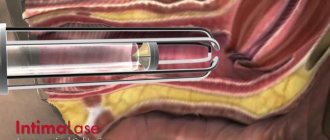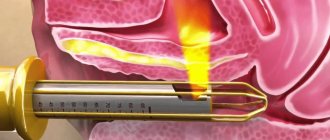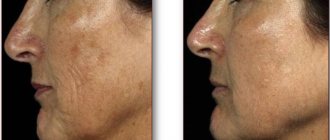Laser vaginal tightening (LVT) is a new non-invasive method of treating vaginal relaxation syndrome, which, along with the intimate filling procedure, is an effective means of combating female sexual dysfunction.
Female sexual dysfunction is a complex psychophysiological problem that includes psychological, neurological, hormonal and physiological aspects. The patient's sexual history and her relationship with her sexual partner play a very important role in a woman's sexual health and influence the sexual pleasure she experiences.
Vaginal relaxation syndrome and vaginal laxity are important factors that contribute to female sexual dysfunction. Most women (and their husbands or partners) refer to vaginal relaxation syndrome as a “weak vagina,” complaining of a loss of firmness, which is directly related to decreased friction during intercourse. Also, one of the manifestations of vaginal relaxation syndrome is the sudden release of air from the vagina during sexual intercourse and physical activity, which is accompanied by a characteristic sound and often confuses women and their sexual partners. Many pregnancies, vaginal births, and the onset of menopause, which causes decreased hormonal levels and vaginal atrophy, contribute to the development of vaginal weakness.
It should be noted that these physiological changes are just part of the overall picture of sexual dysfunction, and correcting only this problem will not necessarily lead to an improvement in the patient’s sexual satisfaction. However, many women seek procedures primarily to treat vaginal laxity in order to improve their sex lives. Due to the increased interest in this problem, many approaches and techniques have been developed to correct and correct vaginal relaxation syndrome and are now used daily throughout the world.
Laser vaginal rejuvenation: who is it indicated for and how can it help?
One of the main indications for laser vaginal rejuvenation is vaginal atrophy.
Vaginal atrophy is a very common problem. It occurs in ½ of all women over 50 years of age.
Vaginal atrophy is characterized by thinning of the vaginal walls, intravaginal dryness and vaginitis due to low levels of estrogen in the blood. This situation often occurs during and after menopause. Low estrogen levels negatively affect primarily the pH level of vaginal secretions.
As a result, symptoms of vaginal atrophy appear:
- Vaginal dryness
- Burning in the vagina
- Discharge
- Genital itching.
Rice. 1. Intimate rejuvenation with CO2 laser
In addition to vaginal atrophy, against the background of a sharp decrease in estrogen in the blood, signs of bladder damage appear, which manifest themselves:
- Burning sensation when urinating
- Urgency to urinate (the patient cannot hold urine for a long time)
- Urinary incontinence
- Frequent cystitis.
In addition, with vaginal atrophy, a woman’s sexual function also suffers:
- Sexual intercourse is accompanied by pain and discomfort
- After sexual intercourse, bleeding from the vagina may occur.
Numerous symptoms can lead to impaired mental health of the patient, depression and mood swings.
Rice. 2. Narrowing of the vagina with a CO2 laser
Destroying myths about vaginal plastic surgery
Intimate plastic surgery still causes fear and shyness in patients, which gives rise to myths and misconceptions around this type of aesthetic medicine. Let’s figure out what is true and what is fiction from “Internet experts.”
Myth No. 1. Vaginal plastic surgery is performed only for medical reasons
A frequent reason for turning to methods of intimate plastic surgery is actually prolapse of the vaginal walls and prolapse of the uterus through the genital fissure. In these cases, surgery is a necessity and is prescribed by a doctor. At the same time, healthy patients who are dissatisfied with the quality of their sexual life also resort to colporrhaphy.
Overstretching of the vaginal walls and muscles during repeated childbirth or heavy physical exertion leads to a decrease in sensitivity during intimacy for both the woman herself and her sexual partner. The situation can be corrected by narrowing the vaginal canal. Women who decide to undergo surgery note that sexual intimacy after vaginal plastic surgery gives them and their partners much more pleasure.
Myth No. 2. Vaginoplasty is a useless operation that only temporarily eliminates sagging, without solving the problems of muscle weakening
The cause of prolapse and prolapse of the vaginal walls is a decrease in the tone of the pelvic muscles of the vaginal walls and their ruptures. At the same time, the term “plasty” misleads patients: they believe that surgery is necessary only to restore visual aesthetics.
In fact, the operation is aimed at restoring the normal position of the internal genital organs. This is achieved by suturing the vaginal walls, damaged muscles, fascia and complete restoration of the pelvic floor.
Suturing the vaginal walls
Myth No. 3. Vaginoplasty is the simplest operation that can be performed by any surgeon.
Intimate plastic surgery requires experience, perfect knowledge of anatomy and a whole range of skills, since accidental cutting of nerve fibers will lead to the woman not being able to experience orgasm. There is a high risk of damage to the bladder or rectum; this causes serious, albeit solvable, problems. In addition, the intervention involves the use of modern complex intravenous general anesthesia, which requires constant monitoring of the patient's condition by an experienced anesthesiologist.
Myth No. 4. Vaginoplasty is performed only to narrow the lumen of the vaginal canal
No, not only that—the operation can also be performed to achieve the opposite effect. There is a rare congenital condition in which the lumen of a woman’s vagina is too narrow, and sometimes short, and the walls of the organ are not elastic. This structure complicates sexual life. Timely vaginal plastic surgery will also help solve this delicate problem.
In this case, the operation is not aimed at suturing the walls, but, on the contrary, at expanding the lumen.
Myth No. 5. The operation is painful, dangerous, after it you will have to forget about intimacy for a long time due to rough internal scars
The operation to correct the vagina is performed under general anesthesia, so the patient sleeps and does not feel anything.
As for scars, in modern clinics plastic surgery is performed using modern technologies and special self-absorbing threads. In these cases, no rough scars remain.
You will have to forget about your intimate life, but only for 4 weeks. At the same time, you will not be able to sit, however, there are special orthopedic circles or pillows; their use removes this restriction from the day following the operation. And you will even be able to drive a car.
Prohibition on sex life
You can lie or stand freely and without restrictions. Lifting weights and going to the gym is acceptable after just a month.
How is vaginal atrophy treated?
Typically, for vaginal atrophy, topical moisturizers are used that do not affect the pH of vaginal secretions and have only a symptomatic effect. These include, for example, Vagisil.
Hormonal treatment is often prescribed for vaginal atrophy. Estrogens can be taken orally or only topically.
Systemic use of estrogens is not safe and may increase the risk of endometrial cancer, ovarian cancer, breast cancer, and cardiovascular disease.
Therefore, in most cases, estrogens are used only intravaginally in the form of creams and suppositories.
Estrogens, when applied topically, appear to be relatively safe and beneficial, causing a decrease in the symptoms of vaginal atrophy due to their pronounced therapeutic effect. However, there are still cases when even local use of hormones is undesirable. For example, the use of hormones is undesirable against the background of breast cancer.
That. To treat this group of patients, it is advisable to use non-hormonal treatment methods that can eliminate the symptoms of vaginal atrophy and urinary incontinence.
A peculiarity of the use of local estrogen-containing preparations is that the cream should be applied to the vagina 2-3 times a week. Many patients find this problematic and forget to do it in a timely manner, which reduces the effectiveness of treatment. In addition, the effect of treatment occurs only after several months or may not occur at all. And also the risk of treatment may exceed its possible benefits.
Rice. 3. Reaction of the vaginal wall to CO2 laser
How a laser works to tighten the vagina
The CO2 laser beam penetrates 0.5mm deep into the vaginal wall, leaving small white dots on the surface in the form of a grid. The laser beam stimulates reparative processes, as a result of which collagen begins to be produced, which causes compaction and thickening of the vaginal wall.
Rice. 2. Nozzle for delivering the laser beam to the vagina
Lasers in the treatment of vaginal atrophy and urinary incontinence
Lasers began to be used to treat urogenital symptoms of vaginal atrophy back in the 80s of the last century.
The mechanism of action of the laser on the vaginal wall:
- Laser energy heats deep tissue layers
- It stimulates tissue remodeling
- Against this background, the growth factor begins to produce new collagen, elastin and extracellular matrix.
All this leads to the improvement of the vaginal wall due to newly formed tissues.
Laser medicine in gynecology is an effective solution
The use of advanced technologies has opened up new opportunities and significantly improved the quality of treatment. Modern medicine is already unthinkable without the latest equipment. Thus, in gynecology, the laser has become an indispensable assistant.
Laser medicine in gynecology originated in the last decades of the twentieth century, and nowadays it is difficult to imagine progress in gynecology without laser technologies, which have opened up new opportunities in solving numerous medical problems. The development of laser medicine in gynecology follows three main branches - laser surgery (using high-energy medical lasers), laser therapy (using lasers with low-intensity radiation) and laser diagnostics.
How does the vagina respond to laser treatment?
- Thickening of the vaginal mucosa occurs
- Vaginal hydration becomes more pronounced
- Increases the elasticity of the vaginal walls
- The natural pH of vaginal secretions is restored
Results of treatment of vaginal atrophy with CO2 laser based on clinical trial data:
- Decreased severity of urinary incontinence
- The vagina is healthier
- Pain during intercourse has disappeared
- The quality of life of patients has significantly improved
It is especially important that no complications were noted after treatment, although therapy was carried out even in patients suffering from cancer.
Results of using the Fotona IntimaLase technique
Treatment usually consists of two treatment sessions with an interval of 15-30 days; there is no rehabilitation period. The result will be noticeable after the first procedure; women note an increase in the level of sexual satisfaction. In addition, the procedure can eliminate another delicate and often associated problem – urinary incontinence. The contraction of tissue provides improved support for the urethra and reduces urethral mobility, thus eliminating the symptoms of urinary incontinence.
In addition, the Fotona laser is used to solve other gynecological problems:
- for the treatment of cervical erosion,
- ectropions of the cervix,
- when performing labiaplasty,
- for removal of soft tissue formations of the urogenital area (papillomas, condylomas, warts),
- to remove hyperpigmentation of the urogenital area by grinding.
Make an appointment
How is laser vaginal rejuvenation performed?
- The procedure is short and takes on average from 5 to 15 minutes.
- She does not require hospitalization
- Painless
- The full course consists of 3 procedures at intervals of 4-6 weeks
- No special preparation is required. However, you should refrain from sexual intercourse and the use of lubricants 2 days before your visit to the doctor.
The impact of the CO2 laser is carried out both inside the vagina and outside, on the labia minora and majora, vulva, entrance to the vagina, simultaneously narrowing and rejuvenating them.
Rice. 4. Technique for laser vaginal rejuvenation
Customers' opinions
There are not many reviews about laser rejuvenation of the intimate area on the Internet. Opinions are divided into two camps: some believe that the course of procedures saved their intimate life, while others complain about the almost complete lack of results.
You won’t see negative comments on the official pages of cosmetology clinics. Although on third-party resources, negative reviews about rejuvenation of the intimate area are concentrated around the price. Women are not against the procedure, but believe that its cost is too high.
Whereas the effect is often mediocre: for serious problems, laser can no longer help, and for mild ones, the result will be almost unnoticeable. But at the same time, reviews prove that the body’s reaction plays a decisive role in the success of the procedure. Therefore, for some, non-ablative rejuvenation can truly be a salvation.
Absolute contraindications for all of the listed procedures:
- pregnancy;
- destruction, wounds and bleeding of the vagina;
- I phase of the menstrual cycle;
- genital and urinary tract infections;
- taking photosensitizing drugs.
These procedures are carried out exclusively on SP Dynamis Pro and XS Dynamis laser systems, as they are patented technologies.
Fotona laser systems have undeniable advantages in gynecological procedures compared to competitive devices.
- Fotona SMOOTH® is the only technology approved by the FDA, the most stringent certification system in the world.
- Gynecological laser procedures performed using Fotona equipment do not damage the treated tissues and, therefore, are absolutely comfortable and have no recovery period.
- Convenient and ergonomic working parts of lasers allow for precise processing, eliminating “gaps” or overheating of tissues.
Do you want to know where you can undergo laser gynecology procedures, find out the prices for procedures and make an appointment? A list of clinics using Fotona laser equipment is available on our website, where they will give you a full diagnosis and help you choose the necessary therapy.
Are you a gynecologist?
Do you want to expand the range of services in your clinic and use the Fotona medical laser device in gynecology? Receive an individual offer and your laser price. Leave a request via the feedback form. Offices in Moscow, St. Petersburg and Kyiv. Delivery throughout the Russian Federation, Kazakhstan, Ukraine and Belarus.
Leave a request to purchase a laser
The MonaLisa Touch technique can be characterized as:
- effective (changes and pathologies are eliminated that previously could only be eliminated through surgery, and for most patients JUST ONE PROCEDURE is sufficient);
- safe (burns and other complications are excluded);
- giving a long-term result (the effect of the procedure usually lasts throughout life, repeating may be required in extremely rare cases).
The advantages of the technique also include painlessness, a quick recovery period (only a week with minor restrictions), the ability to simultaneously eliminate aesthetic defects and solve functional problems, and no need to take medications.
Intimate rejuvenation
IntimaLase™ is a patented technique for non-invasive laser vaginal rejuvenation and treatment of vaginal relaxation syndrome.
Fast, uniform and controlled heating has a beneficial effect on the structure of collagen: previously stretched fibers are reduced by almost 2/3, and the production of new collagen fibers is activated. Restructuring and renewal of the protein framework increases the elasticity and tone of the walls of the relaxed (stretched) vagina after natural childbirth.
During the procedure and Er:YAG laser treatment, the stacked pulse mode of FotonaSmooth® acts on the vaginal mucosa without damaging it. Laser pulses provide fast, effective heating; thermal energy not only effectively improves the structure of collagen, but also stimulates neocollagenesis. As a result of laser exposure, the intermolecular cross-links of the collagen triple helix are shortened, which leads to an instant reduction of the fibers by two-thirds of their length compared to the state before the procedure. As a result of these processes, the treated tissue is enriched with new, young collagen and becomes firm and elastic. The atonicity of the vagina is reduced, the effects of vaginal relaxation syndrome are eliminated.
- Increased sensations during intimate intercourse, a more “bright” orgasm, stimulation of the activity of the “G” point;
- Increasing the elasticity and tone of the vaginal walls, reducing its volume;
- The procedure does not have a rehabilitation period, and after 72 hours the patient can return to an active sexual life;
- The duration of the procedure is about 20 minutes;
- No pain during or after treatment.
The course of laser treatment is prescribed by a doctor
, usually in the form of 2 sessions with an interval of 2-4 weeks. One session includes treatment of the vaginal canal, as well as the vestibule and vaginal opening.
Most common indications:
- vaginal relaxation syndrome;
- prolapse of the walls of the genitals (vagina);
- some variants of sexual dysfunction, discomfort in sexual life.
Relative readings:
age over 40 years.
The procedure is especially effective for the treatment and prevention of “stretched” vaginal syndrome (relaxation).
Treatment of genital prolapse
ProlapLase™ is a patented laser treatment technique for genital prolapse .
The specific radiation of an erbium laser has a restorative effect on the pelvic floor muscles, which can reduce the severity of prolapse or even compensate for the initial stages. The formation and growth of the vaginal mucosa and wall epithelium are also observed. A side effect is a decrease in the severity of dyspareunia.
Uses the gentle, non-ablative photothermal effects of FotonaSmooth® to contract tissue, reduce vaginal lumen, and narrow the vestibule and introitus. Clinical studies have proven that this is an effective, simple and safe procedure. The FotonaSmooth® procedure provides an effective treatment for stress urinary incontinence and genital prolapse. Analysis of clinical results showed the following treatment effects:
- Restored pelvic floor muscles reduce the severity of prolapse by one degree and compensate for the initial stages of the disease;
- Reducing the negative consequences of the disease (dyspareunia, burning, itching and dryness);
- Formation and growth of the lamina of the vaginal mucosa;
- Increase in epithelial thickness;
- The duration of the procedure is about 20 minutes;
- No pain during or after treatment.
Main indication for the procedure
: prolapse of the vaginal walls and pelvic floor.
Contraindications
There are contraindications for any medical intervention or treatment, laser procedures are no exception. Obstacles to implementation may be temporary or permanent.
Temporary include any inflammatory processes in the intimate area, gynecological diseases, and exacerbations of chronic pathologies. If a woman is planning a pregnancy, or is already pregnant, it is better to postpone laser rejuvenation. The same applies to the period of breastfeeding: you must wait until it is completed.
Absolute contraindications include:
- diseases associated with blood clotting disorders;
- the presence of moles in the intimate area;
- diabetes mellitus of any type;
- malignant and benign tumors;
- diseases of autoimmune origin.
The postoperative period is not an absolute contraindication, but during this time the risk of complications increases. Therefore, if there is no urgent need to use a laser, it is better to postpone the operation until complete recovery. You will also need to reschedule the procedure if your temperature rises and other symptoms of a cold occur.
Qualified specialists never prescribe laser resurfacing immediately after the initial treatment. To exclude the presence of all contraindications, the following tests may be required:
- general blood test, determination of coagulation and sugar levels;
- blood chemistry;
- Analysis of urine;
- oncocytological markers;
- fluorography;
- ECG;
- Ultrasound of the pelvic organs.
Side effects are rare with laser rejuvenation. They can occur if the sanitary conditions of the operation are not observed or the doctor is insufficiently qualified. Adverse consequences may occur as a result of the patient’s incorrect behavior or failure to follow all recommendations during the recovery period.








